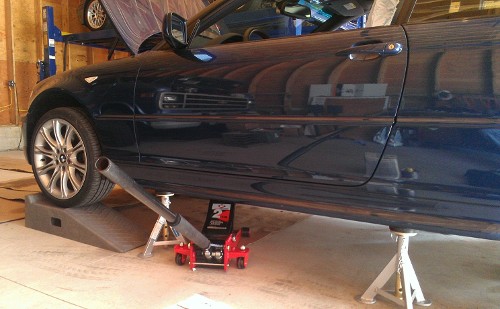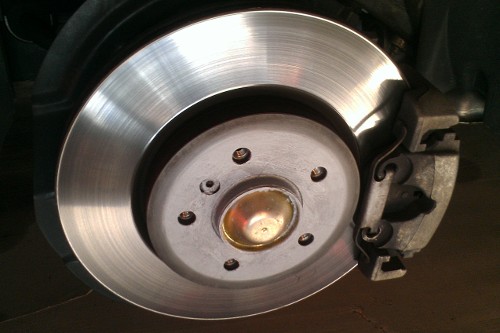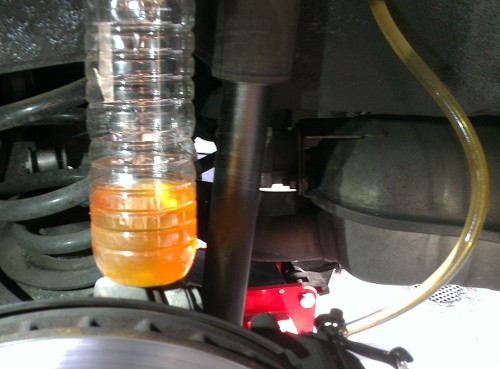Sunday, July 20, 2014
First E46 DIY Brake Fluid Flush
Today I completed the first DIY brake fluid flush on the E46. What normally takes me 2 hours with setup on the E36 (keeping in mind my servicing location is less than convenient) took me the better part of 4 hours on the E46 for several reasons:
- I had never jacked up the front of the E46 before and had to improvise.
- I struggled to get three of the four wheels off the car as they were rusted / bonded to the hubs.
- I had to push a lot more fluid than expected through the system to get it to spew clean fluid.
 First
things first. Jacking the front proved to be a bit more annoying than I thought.
Although my AFF200 jacks are considered “low profile” that's
only true for the front-most section of the jack. After about 12 inches of
reach the height of the jack climbs steeply to a point that it will not fit
under the car at normal ride height. This is normally not a problem if you're
merely trying to reach the outer-most “authorized” jack point,
but as I indicated in an earlier blog entry I could not do this because that
was where I needed to place the jack stand. When I tried to insert the
jack at an angle from behind the jackstand the jack simply did not have enough
reach to meet the inner frame rail far enough forward. Remember – the
point is to jack the front of the car, not lift the entire side of the car,
which is exactly what happens if the jack is too far aft on the frame rail.
First
things first. Jacking the front proved to be a bit more annoying than I thought.
Although my AFF200 jacks are considered “low profile” that's
only true for the front-most section of the jack. After about 12 inches of
reach the height of the jack climbs steeply to a point that it will not fit
under the car at normal ride height. This is normally not a problem if you're
merely trying to reach the outer-most “authorized” jack point,
but as I indicated in an earlier blog entry I could not do this because that
was where I needed to place the jack stand. When I tried to insert the
jack at an angle from behind the jackstand the jack simply did not have enough
reach to meet the inner frame rail far enough forward. Remember – the
point is to jack the front of the car, not lift the entire side of the car,
which is exactly what happens if the jack is too far aft on the frame rail.
I had planned to use some 2x8's to increase clearance but quickly concluded they would not provide all of the clearance required to get the jacks under the car. I knew driving the car up on the ramps would give me that clearance but I also assumed that the ramps themselves would likely reach far enough behind the front wheels to get in the way of the jackstands. That turned out to be the case. My solution was to drive the car up on the ramps, figure out the best position of the jack such that it would not interfere with the jack stands, jack the car up beyond the height of the jackstands, remove the ramps, and then position the jackstands before lowering the vehicle to reset on them.
An interesting aside: at the conclusion of the work session I jacked the front up using both jacks a little at a time and then positioned the ramps under the wheels so I could lower the wheels to rest on them. My goal was to bring the car down the same way it went up -- by lowering each jack a little at a time. To help judge the distance I was lowering each side I used the distance between the tires and ramps as a reference. While lowering the driver's side jack I noticed the tire stop descending just before reaching the ramp and didn't realize what was going on until after I leaned over and looked under the car to find the jack pad well below the frame rail. The passenger side jack was supporting the front end completely. Now that's what I call structural rigidity! The E36's body twists far more than this, I can assure you.
As for my opinion on the ESCO flat top stands? I love them. They make jacking the E36 easier and make jacking the E46 practical. I would not use my Hein Werner stands for the E46 under any condition and may never use them again on the E36 either. Anyone want to buy a set of lightly used Hein Werner jackstands? :)
Stubborn Wheels
 I
knew in the back of my mind that I might have some difficulty removing the
wheels but I had no idea what punishment I was in for today.
I
knew in the back of my mind that I might have some difficulty removing the
wheels but I had no idea what punishment I was in for today.
The left rear was particularly stubborn because it had never been removed since the car was built. After spending way too much time hitting / tugging / rotating / shaking / kicking the wheel I was just about to give up and go home defeated when my brother came to the rescue with a crude but effective technique of sitting in front of the wheel and alternately kicking the sidewall of the tire with a flat foot at the 4 and 8 o'clock positions. The second we both heard the wheel shift to one side he stopped and let me finish the task.
This same technique worked like a charm on the right rear and left front which were just as frozen to the hub as the other wheels. If you're wondering, the right front practically fell off the car after I pulled out the last lug bolt because – surprise, surprise – I had pulled that wheel off a couple years ago after I curbed it and applied anti-size in the way I always do on the E36. This is proof positive that anti-seize is an absolute requirement on the interface between the wheel and hub/rotor. Now at least I know I'll be able to swap wheels on the side of the road in the event of a flat.
Dark Brake Fluid
BMW's recommended interval for a brake fluid flush is 2 years. I unfortunately waited four years for reasons unimportant to this discussion but let's just call that a fluke. For this reason I fully expected to see a bunch of dark brake fluid exit the bleed screws and I wasn't disappointed.
What surprised me was the fact that I had to push a full half liter of fluid through the first circuit (right rear wheel, farthest from the reservoir) before the fluid started to clear. To verify this I had to empty my (partially filled) waste bottle three times to see the color change properly (as putting clear fluid into dark fluid will only slightly lighten it, and certainly not enough to determine if the currently draining fluid is clear as the new stuff). My conclusion? The E46's ABS system holds a bit more fluid than the E36. I don't know for a fact that this is true, but the fluid doesn't lie.
 The
other thing I noticed is that the first bit of fluid to come out of the left
rear caliper was particularly cloudy and seemed to have some fine particulates
in it – probably rust. This is not a good thing, and one of the many
reasons why it's absolutely essential to keep to a schedule. BMW
is a tightwad when it comes to doing proper maintenance on these cars (hint:
their free maintenance schedule is a joke, as it defers a lot of essential
maintenance under the guise of "reducing" maintenance costs on these cars)
and even they recommend brake fluid flushes every two years. That should tell
you something.
The
other thing I noticed is that the first bit of fluid to come out of the left
rear caliper was particularly cloudy and seemed to have some fine particulates
in it – probably rust. This is not a good thing, and one of the many
reasons why it's absolutely essential to keep to a schedule. BMW
is a tightwad when it comes to doing proper maintenance on these cars (hint:
their free maintenance schedule is a joke, as it defers a lot of essential
maintenance under the guise of "reducing" maintenance costs on these cars)
and even they recommend brake fluid flushes every two years. That should tell
you something.
That said, I have a theory – I think the dealer technicians do not push a sufficient amount of fluid through the system when they complete a flush. When my tech told me recently that they typically go through a bottle and a half or so of the BMW stuff on an average flush (which translates to about 500ml given the roughly 300 ml volume per bottle) my spider sense started tingling. While it is true that the most critical fluid to flush is in the calipers and therefore first to exit the bleed screws I think there's something to be said for pushing 800-1000ml (effectively an entire 1 liter can) through the system for every routine flush.
On my E36 I have pushed the better part of a liter through the system every two years and the fluid exiting the bleed screws has never been as brown as it was the first time I did it on that car (see for yourself the contrast between old and new fluid on the Brake Fluid Flush article). Over the years I blew that off as possibly having to do with a difference in lifespan between the BMW fluid and the aftermarket (TYP200) I was using in that car, but today's experience appears to confirm my theory. I won't be able to prove it for another two years however. Stay tuned.
The last thing I noticed during this flush is that I did not seem to be able to remove the strainer in the E46's brake fluid reservoir. I didn't expect this so I didn't research it up front my limited research since hasn't turned up anything useful. I don't know if there's a trick or special tool required to remove the filter but I can tell you that the restricted opening prevented me from inserting my irrigation syringe far enough into the reservoir to extract all of the fluid. That may in part explain why it took me longer to flush the first line. I tried rotating the strainer and pulling up, thinking that it was a “twist and lock” arrangement but that didn't work either. If anyone has figured out how to remove the strainer please let me know.
Mileage: 15900



